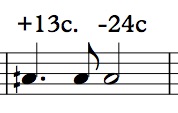Microtonality refers to the use of pitches that are within the interval of a semitone. These may be quarter tones, or other divisions of the semitone. Notably, the concept of a semitone has meant different things at different times throughout the history of Western art music.[1] For the purposes of this study, when using the term semitone, I refer to the most commonly understood meaning of a semitone in the 21st century, that is, an equally-tempered interval.
Descriptions of microtonality in Western art music date back at least as far as the 16th century where microtones may have been used in embellishments. Ganassi describes what may be interpreted as microtonality in ornamentation in his Opera Intitulata Fontegara (1535/1959, p. 87), where he gives fingerings for recorder trills that produce a range of intervals from microtones up to major thirds (Kite-Powell, 2007, pp. 315-316).
There are numerous examples of microtonality in music composed for the modern violin since the middle of the 20th century,[2] with increasing frequency into the late 20th and early 21st centuries. Specific examples can be found in Brian Ferneyhough’s Intermedio of 1986 and Richard Barrett’s air of 1994, performances of which can be found in the second instalment of the Recitals, Yet We Must Go On.
Microtonality on the baroque violin:
In addition to early repertoire for the baroque violin, which is often embellished with microtonal ornaments as described above, several of the works discussed in this research project employ microtonality. These include Jacob Abela’s In Consequence (2018), Alexander Garsden’s Law II (2013), Vincent Giles’ silver as catalyst in organic reactions (2016), and Samuel Smith’s archive (2017a). Natasha Anderson’s 2018 work, The Target Has Disappeared, employs a just intonation temperament, which, if we define microtones as being between equally tempered semitones, is one form of a microtonal tuning system.
The following is an example of quarter tones in the violin part of Jacob Abela’s In Consequence (2018, p. 3).
Video 20.1 – excerpt from violin part of In Consequence by Jacob Abela (2018, p. 3), bar 20
Figure 20.1 – excerpt from violin part of In Consequence by Jacob Abela (2018, p. 3), bar 20
The following is an example of microtonality in just intonation in Natasha Anderson’s The Target Has Disappeared (2018, p. 5). In this example, the bottom stave represents the approximate microtonal position required to achieve the sounding pitch indicated in the upper stave, which also shows the frequency of the required pitches in Hertz.
Video 20.2 – excerpt from first movement of The Target Has Disappeared by Natasha Anderson (2018, p. 5), bars 53–54
Figure 20.2 – excerpt from first movement of The Target Has Disappeared by Natasha Anderson (2018, p. 5), bars 53–54
Suggested notation:
For quarter tones, conventions exist as follows:
Figure 20.3 – conventions for notating, G natural, A ¾ tone flat, A flat, A ¼ tone flat, A natural, A ¼ tone sharp, A sharp, A ¾ tone sharp, B natural
For specific intervals that are not equally tempered, notate the nearest quarter tone then indicate, above the stave, the number of cents + or – away from the notated quarter tone. For instance:
Figure 20.4 – notation for equally tempered A 1/4 tone sharp +13 cents, A 1/4 tone sharp -24 cents
Alternatively, give the frequency in Hertz above the note, as in Figure 20.2 above.
___________________________________________________________________________________________________
[1] For interesting discussions about different interpretations of intervals in Western art music, see Barbour (2004) and Duffin (2007).
[2] For instance, in music by composers such as Charles Ives, and Ivan Wyschnegradsky (Griffiths, Lindley, & Zannos, 2001). It is also worth noting Béla Bartók’s Sonata for Solo Violin here (Bartók, 1947). However, the edition cited here is edited by Yehudi Menuhin, for whom the piece was composed, and does not feature any microtonal notation. During a lesson I undertook in San Diego in 2013 with the late Hungarian violinist János Négyesy, who was personally acquainted with both Bartók and Menuhin, Négyesy told me that Menuhin did not like playing the microtones in this piece because he feared his audience would think he was playing out of tune. (Négyesy, personal communication, 2013). The topic of Menuhin’s relationship with Bartók and his involvement in this edition of the Sonata for Solo Violin is discussed in detail in Oliver Yatsugafu’s Doctor of Musical Arts dissertation (Yatsugafu, 2011, pp. 22-31).



